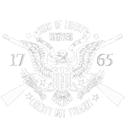
It is impossible to recount the Sons of Liberty's history without first describing the formation of the Loyal Nine.
In 1765, in response to the Stamp Act crisis, a group of merchants and artisans known as the Loyal Nine, or the Loyal Nine of Boston, gathered in Boston. Similar to the Sons of Liberty, the Loyal Nine contributed to the resistance against British taxation and policies during the early colonial period. The following is a synopsis of the Loyal Nine:
1. Origins: Stamp Act Crisis: The Loyal Nine was established during the Stamp Act crisis, an epoch marked by escalating tensions between the United States colonies and Great Britain precipitated by the British government's imposition of direct taxes on a variety of paper products.
A reaction to the Stamp Act, the Loyal Nine was established to voice dissent towards what they perceived to be an inequitable imposition of taxes and the absence of colonial representation in the British Parliament.
2. Prominent Personas: Artisans and Merchants the Loyal Nine comprised artisans and merchants, among others, who belonged to a variety of social classes. Although the precise identities of all nine members remain uncertain, notable individuals affiliated with the organization consist of Ebenezer Mackintosh, Isaiah Thomas, and John Smith.
3. Engagements: Public Demonstrations: In opposition to the Stamp Act, the Loyal Nine participated in public demonstrations. They engaged in street theater, organized demonstrations, and erected effigies as means of expressing their displeasure with British policies.
Early Phases of Sons of Liberty Formation: The Loyal Nine were instrumental in the formation of the Sons of Liberty. With the escalation of tensions, the Loyal Nine underwent a transformation into the Sons of Liberty, a more sizable and structured organization comprising chapters in numerous colonies.
4. Symbolism: The Loyal Nine, akin to the subsequent Sons of Liberty, embraced emblematic figures including the Liberty Tree, which held great importance within the colonial resistance movement.
5. Integration into the Sons of Liberty following dissolution: As a result of the expansion of their activities and influence, the Loyal Nine eventually merged with the Sons of Liberty. The Sons of Liberty coordinated colonial resistance against British policies in a more prominent and organized fashion.
6. Endowment: Support for Colonial Unity and Resistance: Although the Loyal Nine failed to establish a lasting presence, its endeavors and constituents made significant contributions to the overarching movement advocating for colonial unity and opposition. Numerous individuals who were affiliated with the Loyal Nine maintained significant contributions to the American Revolution.
By means of its initial endeavors and subsequent union with the Sons of Liberty, the Loyal Nine played a pivotal role in establishing the foundation for structured colonial resistance against British governance and taxation, thereby ultimately aiding the broader American independence movement.
Establishment of the Sons of Liberty
In the years preceding the American Revolution, specifically during the American colonial period, a clandestine organization known as the Sons of Liberty was established. Its contribution to the resistance against British taxation and other perceived oppressive measures was substantial. The following is a concise account of the Sons of Liberty's inception:
1. Context: The Stamp Act Crisis of 1765: The American colonists expressed strong opposition and protests against the Stamp Act of 1765, which levied direct taxes on a range of paper products. They argued that the taxation policy infringed upon their right to be taxed without representation in the British Parliament.
2. Inception in Boston: Formation It is commonly believed that The Sons of Liberty was founded in Boston, and Samuel Adams and John Hancock are regarded as two of its most influential founders. It originated as a loose-knit organization comprised of individuals who shared similar views and opposed British taxation and other policies they deemed to be violations of colonial rights.
3. Symbolism: The Sons of Liberty employed emblematic pieces of artwork, including the Liberty Tree and the Liberty Pole, to symbolize their cause. Protesters frequently employed these symbols, which also functioned as focal points for anti-British sentiments.
4. Protests and Actions: Boycotts and Demonstrations: The Sons of Liberty orchestrated and spearheaded boycotts of British commodities, thereby exerting economic coercion on the governing authorities. In addition, they coordinated public outcations and demonstrations, such as the notorious Boston Tea Party of 1773.
5. Communication Networks: Committees of Correspondence: Established by the Sons of Liberty, these committees served as communication networks between the colonies. The committees in question served to facilitate the flow of information pertaining to British actions and to coordinate reactions to perceived challenges to colonial liberties.
6. Mobilization: In the midst of escalating tensions between Great Britain and the American colonies, the Sons of Liberty assumed a pivotal function in galvanizing public opinion in support of the cause of independence. Many members later rose to positions of revolutionary movement leadership.
7. In the Sons of Liberty, a number of notable individuals, including John Hancock and Samuel Adams, contributed significantly to the formulation of the Declaration of Independence and the formation of the United States of America.
Instead of being a formal organization with a centralized structure, The Sons of Liberty operated as an informal network of individuals who were interconnected and pursued shared objectives. Acting as a catalyst for colonial unity and opposition to British policies, it made a substantial contribution to the sequence of events culminating in the American Revolution.
Copyright 2004-2024 United Sons Of Liberty Foundation All Rights Reserved.